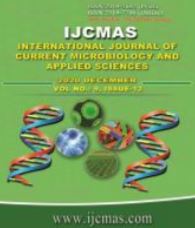


 National Academy of Agricultural Sciences (NAAS)
National Academy of Agricultural Sciences (NAAS)

|
PRINT ISSN : 2319-7692
Online ISSN : 2319-7706 Issues : 12 per year Publisher : Excellent Publishers Email : editorijcmas@gmail.com / submit@ijcmas.com Editor-in-chief: Dr.M.Prakash Index Copernicus ICV 2018: 95.39 NAAS RATING 2020: 5.38 |
The Pokkali field is a unique eco-system prevailing in the coastal tract of Kerala with rich bio diversity and amazing capacity to produce organic rice and shrimp alternatively. The various farming operations in Pokkali paddy cultivation, the harvesting is done by women labourers by walking on the swampy and marshy inundated paddy fields at waist-deep water, which is laborious, tedious and cumbersome. Though a number of paddy combine harvesters are commercially available, none cannot be used in such marshy water logged areas for harvesting paddy. Hence, a power operated floating harvester with provisions for harvesting and conveying the ear heads of submerged paddy. Overall size of the Pokkali paddy harvester is 6.2 x 1.7 x 1.7 m with a total weight of about 1700 kg. A Pokkali paddy harvester is designed in such a way that to suit for fragmented Pokkali areas. The vertical centre of gravity of the harvester is 0.58 m, longitudinal centre of gravity is 2.67 m and transverse centre of gravity is zero. As the transverse centre of gravity is zero, Pokkali paddy harvester is stable to float and longitudinal centre of gravity lies near to the centre and adjacent to the front and rear side of the harvester, it become a well-balanced machine.
 |
 |
 |
 |
 |